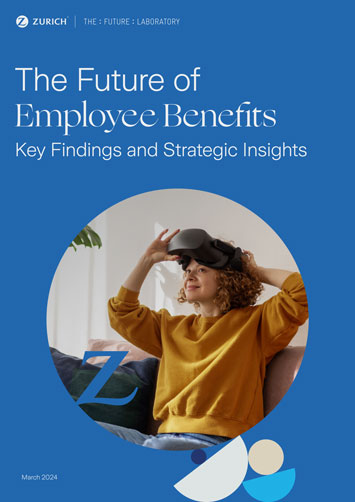
What is a human-first approach to employee benefits?
Organizations should consider placing wellbeing, technology, inclusivity and social good at the heart of their benefits packages.
Related download
The workforce is changing. Many employees are no longer office-based employees; they are demanding more flexibility and greater purpose. They are multi-role professionals with big ambitions and they have never been more discerning about their benefits packages. They don't just want pensions and holidays — they are seeking enhanced care for their social, financial, mental and physical wellbeing.
The one-size-fits-all benefits package is no longer fit for purpose. Instead, employers should consider adopting a human-first approach to benefits that facilitates choice, promotes transparency and aligns with the values of their employees. A new report, The Future of Employee Benefits: 2030 from Zurich Integrated Benefits, explores what the benefits landscape might look like in 2030 with a series of hypothetical scenarios across five key areas: wellbeing, personalization, empowerment, impact and technology.

The changing landscape of employee benefits
The expectations of employees will change dramatically as we approach 2030. They will increasingly demand benefits that are meaningful and tailored to fit their goals, not their roles. The report finds that just 21 percent of today’s employees feel that their benefits align closely with what is important to them, so corporations will need to rethink the employee experience and expand their offering.
Key pillars of a human-first approach
Almost two-thirds (62 percent) of employees would exchange their work-related data for more customizable compensation, rewards and benefits, so employers should start providing and preempting the end-to-end flexibility that employees want. Adjustable working hours, work-from-anywhere schemes and pick-and-choose health benefits are all examples of ways that employers can promote greater personalization.
Integrating health and wellness into every aspect of the employee experience is vital for maintaining engagement. Workers who feel their organization prioritizes their wellbeing are 69 percent less likely to seek a new role. Prevention will take precedence over cure in the 2030 employee landscape, and workers will expect their employers to consider their wellbeing. Employers can cultivate a benefits system with wellness at its core with innovations like early warning systems to detect burnout, customizable life insurance and online mindfulness sessions.
Employers will need to use established and emerging technologies to keep their benefits offerings competitive. Over a quarter (28 percent) of employees are dissatisfied with, or unable to access, a single platform for their benefits. Organizations will need to move with the times by harnessing technology such as generative AI and the Internet of Things to supercharge their benefits with real-time data and smart insights into employee satisfaction.
Human-first benefits must also be inclusive by design. A diverse, multigenerational workforce will have differing needs and expectations, so organizations should find ways to incorporate a range of employee voices in their benefits ecosystem to ensure providers address this. Employers can create working groups that have a hand in benefits decision-making and hold focus groups to ensure their benefits are aligned with employee expectations.
Organizations will increasingly need to act as forces for good in society to ensure they embody the values of their people. Nine in 10 (87 percent) Gen Z professionals in Europe would quit their job if the values of their employer weren’t aligned with their own. Employers will need to act as educators and enablers who inspire their people to take positive action. They could, for example, give employees paid time off to volunteer at a community allotment or invest company pensions into climate-friendly portfolios.
How can employers prepare for the future?
Organizations need to underscore their human-first approach to benefits with a commitment to end-to-end flexibility, providing employees with a range of benefits and allowing them to choose the ones that fit their needs and goals best. Data will play a pivotal role in helping employers realize this – employers should underpin their benefits packages with high-quality data that enables them to measure success and maximize their offerings. And employees should feel empowered to contribute to benefit decision-making so that offerings reflect their diverse needs and wants.
The shift to a human-first approach will include its challenges. The future of employee benefits will be built on data, so organizations must ensure that their data pools are not only rich but secure as well. Ethical use of data will be another key consideration as the transparency of benefits and organizational decision-making becomes even more important for employees. But the greatest challenge for employers will be striking a balance between offering robust benefits packages and meeting the needs of a multigenerational workforce.
Employee expectations will continue to change as we approach the end of the decade. Organizations need to meet the diverse and growing needs of their employees with benefits packages that are transparent and data-led, and which place the wellbeing of workers at their core. Read The Future of Employee Benefits: 2030 to explore the key pillars of a human-first approach in more detail and start creating a benefit offering fit for a workforce that is more discerning than ever before.




